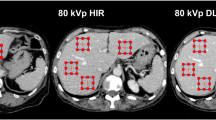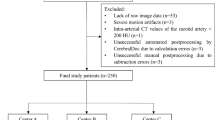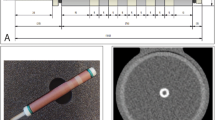Abstract
Purpose
To evaluate the image quality and radiation dose exposure of low-dose coronary CTA (cCTA) study, reconstructed with the new model-based iterative reconstruction algorithm (IMR), compared with standard hybrid-iterative reconstruction (iDose4) cCTA in patients with suspected coronary artery disease.
Materials and methods
Ninety-eight patients with an indication for coronary CT study were prospectively enrolled. Fifty-two patients (study group) underwent 256-MDCT low-dose cCTA (80 kV; automated-mAs; 60 mL of CM, 350 mgL/mL) with prospective ECG-triggering acquisition and IMR. A control group of 46 patients underwent 256-MDCT standard prospective ECG-gated protocol (100 kV; automated-mAs; 70 mL of CM, 400 mgL/mL; iDose4). Subjective and objective image quality (attenuation value, SD, SNR and CNR) were evaluated by two radiologists subjectively. Radiation dose exposure was quantified as DLP, CTDIvol and ED.
Results
Mean values of mAs were significantly lower for IMR-cCTA (167 ± 62 mAs) compared to iDose-cCTA (278 ± 55 mAs), p < 0.001. With a significant reduction of 38% in radiation dose exposure (DLP: IMR-cCTA 91.7 ± 26 mGy cm vs. iDose-cCTA 148.6 ± 35 mGy cm; p value < 0.001), despite the use of different CM, we found higher mean attenuation values of the coronary arteries in IMR group compared to iDose4 (mean density in LAD: 491HU IMR-cCTA vs. 443HU iDose-cCTA; p = 0.03). We observed a significant higher value of SNR and CNR in study group due to a lower noise level. Qualitative analysis did not reveal any significant differences between the two groups (p = 0.23).
Conclusions
Low-dose cCTA study combined with IMR reconstruction allows to correctly evaluate coronary arteries disease, offering high-quality images and significant radiation dose exposure reduction (38%), as compared to standard cCTA protocol.



Similar content being viewed by others
Reference
Mensah GA, Moran AE, Roth GA, Narula J (2014) The global burden of cardiovascular diseases, 1990–2010. Glob Heart 9(1):183–184. https://doi.org/10.1016/j.gheart.2014.01.008
Fuster V (2014) Global burden of cardiovascular disease: time to implement feasible strategies and to monitor results. J Am Coll Cardiol 64(5):520–522. https://doi.org/10.1016/j.jacc.2014.06.1151
Mozaffarian D, Benjamin EJ, Go AS et al (2015) Heart disease and stroke statistics–2015 update: a report from the American Heart Association. Circulation 131:e29. https://doi.org/10.1161/cir.0000000000000152
Moss AJ, Williams MC, Newby DE, Nicol ED, Nicol ED (2017) The updated NICE guidelines: cardiac CT as the first-line test for coronary artery disease. Curr Cardiovasc Imaging Rep. 10:15. https://doi.org/10.1007/s12410-017-9412-6
Abbara S, Blanke P, Maroules CD et al (2016) Journal of Cardiovascular Computed Tomography SCCT guidelines for the performance and acquisition of coronary computed tomographic angiography: a report of the society of cardiovascular computed tomography guidelines committee endorsed by the North American Society for Cardiovascular Imaging (NASCI). J Cardiovasc Comput Tomogr 10(6):435–449. https://doi.org/10.1016/j.jcct.2016.10.002
Raff GL, Chinnaiyan KM, Cury RC et al (2014) SCCT Guidelines on the use of coronary computed tomographic angiography for patients presenting with acute chest pain to the emergency department: a report of the society of cardiovascular computed tomography guidelines committee. J Cardiovasc Comput Tomogr 8(4):254–271. https://doi.org/10.1016/j.jcct.2014.06.002
Iyama Y, Nakaura T, Kidoh M et al (2016) Submillisievert radiation dose coronary CT angiography: clinical impact of the knowledge-based iterative model reconstruction. Acad Radiol 23(11):1393–1401. https://doi.org/10.1016/j.acra.2016.07.005
Juergens KU, Grude M, Fallenberg EM et al (2002) Using ECG-gated multidetector CT to evaluate global left ventricular myocardial function in patients with coronary artery disease. AJR Am J Roentgenol 179(6):1545–1550. https://doi.org/10.2214/ajr.179.6.1791545
Raff GL, Gallagher MJ, O’Neill WW, Goldstein JA (2005) Diagnostic accuracy of noninvasive coronary angiography using 64-slice spiral computed tomography. J Am Coll Cardiol 46(3):552–557. https://doi.org/10.1016/j.jacc.2005.05.056
Scheffel H, Alkadhi H, Plass A et al (2006) Accuracy of dual-source CT coronary angiography: first experience in a high pre-test probability population without heart rate control. Eur Radiol 16(12):2739–2747. https://doi.org/10.1007/s00330-006-0474-0
Aurumskjöld ML, Ydström K, Tingberg A, Söderberg M (2016) Model-based iterative reconstruction enables the evaluation of thin-slice computed tomography images without degrading image qualityor increasing radiation dose. Radiat Prot Dosimetry 169(1):100–106. https://doi.org/10.1093/rpd/ncv474
Alkadhi H, Schindera ST (2011) State of the art low-dose CT angiography of the body. Eur J Radiol 80(1):36–40. https://doi.org/10.1016/j.ejrad.2010.12.099
Di Cesare E, Gennarelli A, Di Sibio A et al (2014) Assessment of dose exposure and image quality in coronary angiography performed by 640-slice CT: a comparison between adaptive iterative and filtered back-projection algorithm by propensity analysis. Radiol Med. 119(8):642–649. https://doi.org/10.1007/s11547-014-0382-3
Di E, Gennarelli A, Di A et al (2018) Image quality and radiation dose of single heartbeat 640-slice coronary CT angiography: a comparison between patients with chronic atrial fibrillation and subjects in normal sinus rhythm by propensity analysis. Eur J Radiol 84(4):631–636. https://doi.org/10.1016/j.ejrad.2014.11.035
Sagara Y, Hara AK, Pavlicek W, Silva AC, Paden RG, Wu Q (2010) Abdominal CT: comparison of low-dose CT with adaptive statistical iterative reconstruction and routine-dose CT with filtered back projection in 53 patients. Am J Roentgenol 195(3):713–719. https://doi.org/10.2214/AJR.09.2989
Nakaura T, Nakamura S, Maruyama N et al (2012) Low contrast agent and radiation dose protocol for hepatic dynamic CT of thin adults at 256–detector row CT: effect of low tube voltage and hybrid iterative reconstruction algorithm on image quality. Radiology 264(2):445–454. https://doi.org/10.1148/radiol.12111082
Mehta D, Thompson R, Morton T, Dhanantwari A, Shefer E, Healthcare P (2013) Iterative model reconstruction: simultaneously lowered computed tomography radiation dose and improved image quality. Med Phys Int 1(2):147–155. https://doi.org/10.1117/12.2007525
Leschka S, Stolzmann P, Schmid FT et al (2008) Low kilovoltage cardiac dual-source CT: attenuation, noise, and radiation dose. Eur Radiol 18(9):1809–1817. https://doi.org/10.1007/s00330-008-0966-1
Nakaura T, Awai K, Maruyama N et al (2011) Abdominal dynamic CT in patients with renal dysfunction: contrast agent dose reduction with low tube voltage and high tube current-time product settings at 256–detector row CT. Radiology 261(2):467–476. https://doi.org/10.1148/radiol.11110021
Schindera ST, Graca P, Patak MA et al (2009) Thoracoabdominal-aortoiliac multidetector-row CT angiography at 80 and 100 kVp: assessment of image quality and radiation dose. Invest Radiol 44(10):650–655. https://doi.org/10.1097/RLI.0b013e3181acaf8a
Kubo S, Tadamura E, Yamamuro M et al (2007) Multidetector-row computed tomographic angiography of thoracic and abdominal aortic aneurysms: comparison of arterial enhancement with 3 different doses of contrast material. J Comput Assist Tomogr 31(3):422–429. https://doi.org/10.1097/01.rct.0000237819.64419.d2
Joshi SB, Mendoza DD, Steinberg DH et al (2009) Ultra-low-dose intra-arterial contrast injection for iliofemoral computed tomographic angiography. JACC Cardiovasc Imaging 2(12):1404–1411. https://doi.org/10.1016/j.jcmg.2009.08.010
Kubo S, Tadamura E, Yamamuro M et al (2006) Thoracoabdominal-aortoiliac MDCT angiography using reduced dose of contrast material. AJR Am J Roentgenol 187(2):548–554. https://doi.org/10.2214/AJR.05.0309
Martin ML, Tay KH, Flak B et al (2003) Multidetector CT angiography of the aortoiliac system and lower extremities: a prospective comparison with digital subtraction angiography. AJR Am J Roentgenol 180(4):1085–1091. https://doi.org/10.2214/ajr.180.4.1801085
Tepel M, Aspelin P, Lameire N (2006) Contrast-induced nephropathy: a clinical and evidence-based approach. Circulation 113(14):1799–1806. https://doi.org/10.1161/CIRCULATIONAHA.105.595090
Nkomo VT, Gardin JM, Skelton TN, Gottdiener JS, Scott CG, Enriquez-Sarano M (2006) Burden of valvular heart diseases: a population-based study. Lancet 368(9540):1005–1011. https://doi.org/10.1016/S0140-6736(06)69208-8
Huda W, Scalzetti EM, Levin G (2000) Technique factors and image quality as functions of patient weight at abdominal CT. Radiology 217(2):430–435. https://doi.org/10.1148/radiol.12120134
Deak PD, Smal Y, Kalender WA (2010) Multisection CT protocols: sex-and age-specifi c conversion factors used to determine effective dose from dose-length product 1. Radiol Radiol 257(1-October):158–166. https://doi.org/10.1148/radiol.10100047/-/dc1
Park CH, Lee J, Oh C, Han KH, Kim TH (2015) The feasibility of sub-millisievert coronary CT angiography with low tube voltage, prospective ECG gating, and a knowledge-based iterative model reconstruction algorithm. Int J Cardiovasc Imaging 31(2):197–203. https://doi.org/10.1007/s10554-015-0795-7
Löve A (2013) Optimization of image quality and radiation dose in neuroradiological computed tomography. Diagnostic Radiology, (Lund), Lund University
Puchner SB, Ferencik M, Karolyi M et al (2013) The effect of iterative image reconstruction algorithms on the feasibility of automated plaque assessment in coronary CT angiography. Int J Cardiovasc Imaging 29(8):1879–1888. https://doi.org/10.1007/s10554-013-0281-z
Ghekiere O, Salgado R, Buls N et al (2017) Image quality in coronary CT angiography: challenges and technical solutions. Br J Radiol 90(1072):20160567. https://doi.org/10.1259/bjr.20160567
Achenbach S, Paul JF, Laurent F et al (2017) Comparative assessment of image quality for coronary CT angiography with iobitridol and two contrast agents with higher iodine concentrations: iopromide and iomeprol. A multicentre randomized double-blind trial. Eur Radiol 27(2):821–830. https://doi.org/10.1007/s00330-016-4437-9
Barras H, Dunet V, Hachulla A-L, Grimm J, Beigelman-Aubry C (2016) Influence of model based iterative reconstruction algorithm on image quality of multiplanar reformations in reduced dose chest CT. Acta Radiol Open 5(8):1–9. https://doi.org/10.1177/2058460116662299
Sigal-Cinqualbre AB, Hennequin R, Abada HT, Chen X, Paul J-F (2004) Low-kilovoltage multi-detector row chest CT in adults: feasibility and effect on image quality and iodine dose. Radiology 231(1):169–174. https://doi.org/10.1148/radiol.2311030191
Author information
Authors and Affiliations
Corresponding author
Ethics declarations
Conflict of interest
All the authors are aware of the content of the manuscript and have no conflict of interest.
Ethical standards
All procedures performed in studies involving human participants were in accordance with the ethical standards of the institutional and/or national research committee and with the 1964 Helsinki declaration and its later amendments or comparable ethical standards.
Informed consent
Informed consent was obtained from all individual participants included in the study.
Rights and permissions
About this article
Cite this article
Ippolito, D., Riva, L., Talei Franzesi, C.R. et al. Diagnostic efficacy of model-based iterative reconstruction algorithm in an assessment of coronary artery in comparison with standard hybrid-Iterative reconstruction algorithm: dose reduction and image quality. Radiol med 124, 350–359 (2019). https://doi.org/10.1007/s11547-018-0964-6
Received:
Accepted:
Published:
Issue Date:
DOI: https://doi.org/10.1007/s11547-018-0964-6




